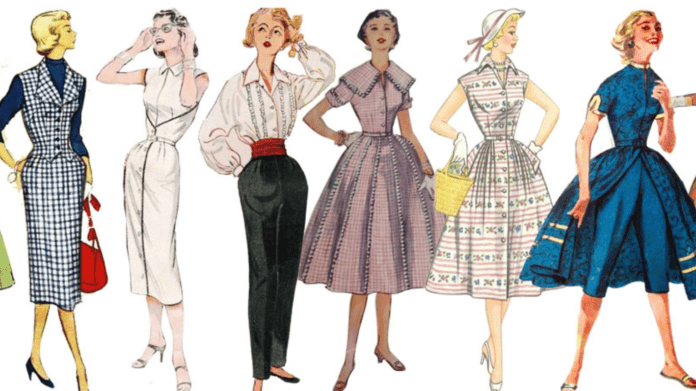Introduction:
For fashion 1953 was a monumental year. The clash of traditional elegance and new invention shaped fashion trends. 1950s fashion was broad and multidimensional from Hollywood stars’ beautiful ensembles to common people’s utilitarian but elegant attire. This article examines significant 1953 fashion trends and how they defined the decade and still affect fashion today.
The Golden Age of Hollywood Glamour: Fashion on the Silver Screen
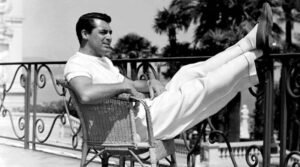
Hollywood was at its best in 1953. Audrey Hepburn Grace Kelly and Marilyn Monroe set the tone for the decade with their stylish choices. Luxury refinement and a polished image defined Hollywood glamor.
Grace Kelly’s 1954 Academy Award for The Country Girl was indicative of her everlasting grace. elegance’s elegant high-neck dresses delicate materials and pastel colors highlighted femininity and elegance. Marilyn Monroe embodied 1950s erotic appeal. In The Seven Year Itch her white halter dress symbolises glamour and Hollywood charm.
On-screen fashions used satin silk and velvet. Christian Dior who established the “New Look” in the late 1940s influenced fashion in 1953 fashion trends. Elegant femininity was shown in this small waist voluminous skirt and rounded shoulders. Hollywood celebs’ lavish fashions influenced ladies worldwide.
The Rise of Suburban Style: Fashion for the Modern American Woman
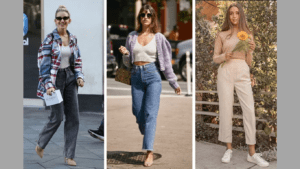
Hollywood stars started the glamor trend in 1953 but the increasing middle class and suburban living also affected fashion. After World War II families moved to the suburbs and fashion followed. The fashions of the period were utilitarian yet stylish suitable for a contemporary lady balancing family and style.
Mass manufacture of garments made women’s fashion more accessible in 1953. Simple utilitarian clothes for work and socializing became fashionable. Dresses with long skirts tight waists and delicate designs were popular. Dresses skirts and blouses made of cotton wool and rayon let women appear stylish without compromising comfort.
The “matching sets” fad also arose. Women wore matched skirts shirts and accessories to seem put-together at home on errands and at parties. The “housewife chic” trend which combined utility with elegance emerged around this time.
The Influence of Haute Couture: Designers Who Defined the Era
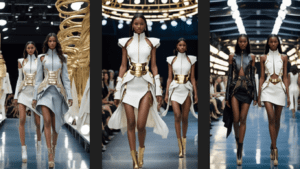
Haute couture ruled fashion in 1953. Fashion icons including Christian Dior Yves Saint Laurent and Hubert de Givenchy influenced women’s runway and street style.
After his 1947 “New Look” Christian Dior ruled fashion in 1953 fashion trends. Hourglass dresses tight corsets and voluminous skirts gave ladies an ultra-feminine look in his creations. Based on waist and breast more structured formal. Gowns were made for elegant evening gatherings.
In the 1950s Dior’s protégé Yves Saint Laurent created waves in fashion. Saint Laurent is designed with clean lines and elegance. His designs were inspired by art typically using surrealism. Saint Laurent produced flattering sophisticated gowns in 1953 a contrast to the decade’s flamboyant trends.
Another renowned designer Givenchy merged traditional elegance with modernism. Audrey Hepburn who donned his designs in Sabrina loved his clean lines. Givenchy’s stylish daywear and exquisite evening dresses made him a major role in 1953’s haute couture.
Men’s Fashion in 1953: A Sharp and Tailored Look
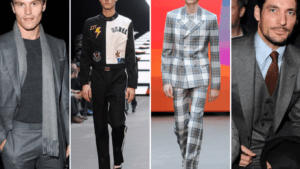
Although women’s fashion in 1953 is generally mentioned men’s fashion was also important. Men returned to sophisticated style after the war adopting precise tailoring and classic designs that dominated the decade. Clean lines fitted clothes and a polished appearance defined the 1950s “Ivy League” image.
Every male had a two-piece suit with slim-fitting pants and single-breasted jackets being fashionable. These suits were worn with white dress shirts slender ties and polished leather shoes. Dark suits like blue charcoal and brown conveyed elegance and maturity. Sport coats wool sweaters and well-tailored pants gave men a polished but accessible look for casual wear.
The 1950s “Mad Men” style impacted casual clothing. Businessmen favored slim-cut suits with thin ties and pocket squares. The 1950s well-dressed guy was well put together.
Casual Style and the Birth of the “Teenager” Look
Casual dress changed in 1953 along with formal and suburban styles. The notion of “teenager” fashion emerged during this time. Youth culture flourished in the 1950s and young people began dressing differently from their parents.
Teens in 1953 adopted more laid-back rebellious styles. Boyhood fashion included leather jackets denim pants and T-shirts popularized by Rebel Without a Cause’s James Dean. Alternatively, girls wore poodle skirts cardigans, and ponytails for a young cheerful, and playful look. The edginess of rock ‘n’ roll resonated with teens throughout the US influencing their wardrobe choices.
Casualwear was growing more popular among adults and teenagers since it was more comfortable than formal clothes. Jeans were a staple of daily clothing in the 1950s due to their popularity, particularly among teens.
Accessories and Footwear: The Finishing Touches of 1953 Fashion
In 1953 accessories were essential to outfits. From flamboyant hats for ladies to crisp neckties for men accessories define one’s style.
Gloves caps scarves and jewelry were worn by women. Women used gloves with skirts and suits to seem sophisticated. Pillbox hats a 1950s fashion icon were also popular with ladies seeking glamor. Small structured hats with ribbons feathers or flowers added beauty to an outfit.
The tie became a major adornment for males. Most suits had skinny silk ties with bright designs or basic hues. As men started to notice fashion elements watches cufflinks and pocket squares became fashionable.
Also prominent in 1953 fashion trends was footwear. Ladies used high heels to lengthen their legs and seem feminine. Stiletto heels debuted in the late 1940s and were increasingly popular in 1953 due to their height and sexiness. Men used polished leather shoes like oxfords and loafers to accentuate their elegant tailored image.
Final Thought:
The fashion trends of 1953 reflected the era and set the stage for style in subsequent decades. The year was great for Hollywood glamor suburban pragmatism teenage revolt and high-fashion refinement. The eternal beauty of Dior’s New Look the casual cool of denim and the stylish accessories that conclude an ensemble all impact fashion today.

